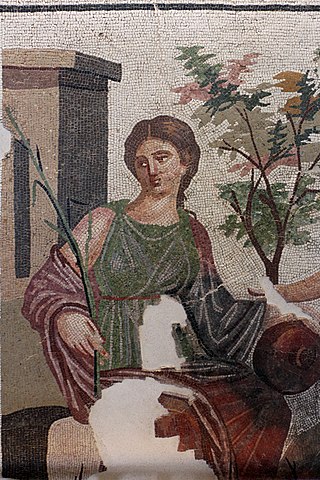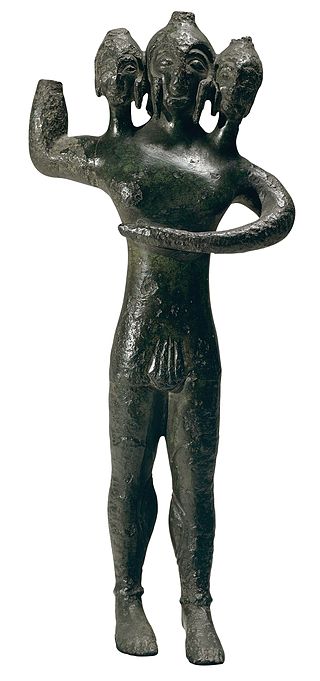Related Research Articles

In ancient Greek mythology and religion, Leto is a goddess and the mother of Apollo and Artemis. She is the daughter of the Titans Coeus and Phoebe, and the sister of Asteria.

A nymph is a minor female nature deity in ancient Greek folklore. Distinct from other Greek goddesses, nymphs are generally regarded as personifications of nature; they are typically tied to a specific place, landform, or tree, and are usually depicted as maidens. Because of their association with springs, they were often seen as having healing properties; other divine powers of the nymphs included divination and shapeshifting. Nymphs, like other goddesses, were immortal except for the Hamadryads, whose lives were bound to a specific tree.

Rhea or Rheia is a mother goddess in ancient Greek religion and mythology, the Titan daughter of the earth goddess Gaia and the sky god Uranus, himself a son of Gaia. She is the older sister of Cronus, who was also her consort, and the mother of the five eldest Olympian gods and Hades, king of the underworld.

In Greek mythology, Erato is one of the Greek Muses, the inspirational goddesses of literature, science, and the arts. The name would mean "desired" or "lovely", if derived from the same root as Eros, as Apollonius of Rhodes playfully suggested in the invocation to Erato that begins Book III of his Argonautica.

Cyrene, also spelled Kyrene is a figure in Greek mythology considered the etymon of the Greek colony of Cyrene in eastern Libya in North Africa. She was said to have been a Thessalian princess who became the queen of Cyrene, founded and named in her honor by the god Apollo. The story is entirely apocryphal, the city having been founded by settlers from Thera.
In Greek mythology, the name Hypseus may refer to:

In Greek mythology, Geryon, also Geryone, son of Chrysaor and Callirrhoe, the grandson of Medusa and the nephew of Pegasus, was a fearsome giant who dwelt on the island Erytheia of the mythic Hesperides in the far west of the Mediterranean. A more literal-minded later generation of Greeks associated the region with Tartessos in southern Iberia. Geryon was often described as a monster with either three bodies and three heads, or three heads and one body, or three bodies and one head. He is commonly accepted as being mostly humanoid, with some distinguishing features and in mythology, famed for his cattle.

In Greek mythology, the Heliades also called Phaethontides were the daughters of Helios and Clymene, an Oceanid nymph.

In Greek mythology, the naiads, sometimes also hydriads, are a type of female spirit, or nymph, presiding over fountains, wells, springs, streams, brooks and other bodies of fresh water.
In Greek mythology, the Limnads or Limnatides or Leimenids were a type of naiad.
In Greek mythology, the Telchines were the original inhabitants of the island of Rhodes and were known in Crete and Cyprus.
In Greek mythology, the name Butes referred to several different people.

In Greek mythology, the Erymanthian boar was a mythical creature that took the form of a "shaggy and wild" "tameless" "boar" "of vast weight" "and foaming jaws". It was a Tegeaean, Maenalusian or Erymanthian boar that lived in the "glens of Lampeia" beside the "vast marsh of Erymanthus". It would sally from the "thick-wooded", "cypress-bearing" "heights of Erymanthus" to "harry the groves of Arcady" and "abuse the land of Psophis".

In Greek mythology, Glaucus was a Greek prophetic sea-god, born mortal and turned immortal upon eating a magical herb. It was believed that he came to the rescue of sailors and fishermen in storms, having earlier earned a living from the sea himself.
In Greek mythology, the name Ismenus or Ismenius may refer to:
In Greek mythology, Ismenis was a naiad nymph, one of the daughters of the Boeotian river god Ismenus: Ismenis is a patronymic rather than a given name.

In Greek mythology, Aeolus or Aiolos was the son of Hellen, the ruler of Aeolia, and the eponym of the Aeolians, one of the four main tribes of the Greeks. According to the mythographer Apollodorus, Aeolus was the father of seven sons: Cretheus, Sisyphus, Athamas, Salmoneus, Deion, Magnes, Perieres, and five daughters: Canace, Alcyone, Pisidice, Calyce, and Perimede. He was said to have killed his daughter Canace because she had committed incest with her brother Macareus. This Aeolus was sometimes confused with the Aeolus who was the ruler of the winds.
In Greek mythology, Strophia was a naiad nymph of a spring on Thebes.
In Greek mythology, Crocale was a naiad in the train of Artemis. She was probably from Thebes by the account of her parentage.
References
- ↑ "Theoi Project - List of Nymphs and types of Nymphs". Archived from the original on 2010-08-20. Retrieved 2010-11-12.
- ↑ Strabo, Geography 8.3.19
- ↑ Pausanias, Guide to Greece 5.5.11
- ↑ Pausanias, Guide to Greece 9.24.4
- ↑ Callimachus, Hymn IV to Delos, 252
- ↑ Pindar, Odes Olympian, 12
- ↑ Diodorus Siculus, Library of History, 5. 5. 1
- ↑ Callimachus, Aitia Fragment 66
- ↑ Gaius Valerius Flaccus, Argonautica 4. 374 ff
- ↑ Tzetzes on Lycophron, 511
- ↑ Pausanias, Guide to Greece 6.22.7
- ↑ Homer, Odyssey 13.96 ff
- ↑ Strabo, Geography 9.2.25; 10.3.17
- ↑ Pausanias, Guide to Greece 9.34.4
- ↑ Apollonius Rhodius, Argonautica 1. 1225 ff.
- ↑ Hyginus, Fabulae 14
- ↑ Theocritus, Idylls, 13. 44
- ↑ Diodorus Siculus, Library of History 5.5.1
- ↑ Ovid, Metamorphoses 11. 762 ff
- 1 2 3 4 Pliny the Elder, Natural History 3. 89, in a list of Sicilian springs, of which only Arethousa and Cyane are known to have been personified
- ↑ Strabo, Geography 6. 2. 4
- ↑ Ovid, Metamorphoses 5. 407 & 487 ff
- ↑ Virgil, Aeneid 3. 694 ff
- ↑ Pausanias, Guide to Greece 10.8.9; 10.24.7
- ↑ Nonnus, Dionysiaca, 2. 143–144 & 40 141-143
- ↑ Bibliotheca 2.6
- ↑ Statius, Thebaid 4.716
- ↑ Quintus Smyrnaeus, Fall of Troy 3.300
- ↑ Plato, Phaedrus 229
- ↑ "Smith, William, Dictionary of Greek and Roman Biography and Mythology, v. 3, page 238". Archived from the original on 2011-05-14. Retrieved 2010-11-12.
- ↑ Callimachus, Hymn 4 to Delos 75 ff